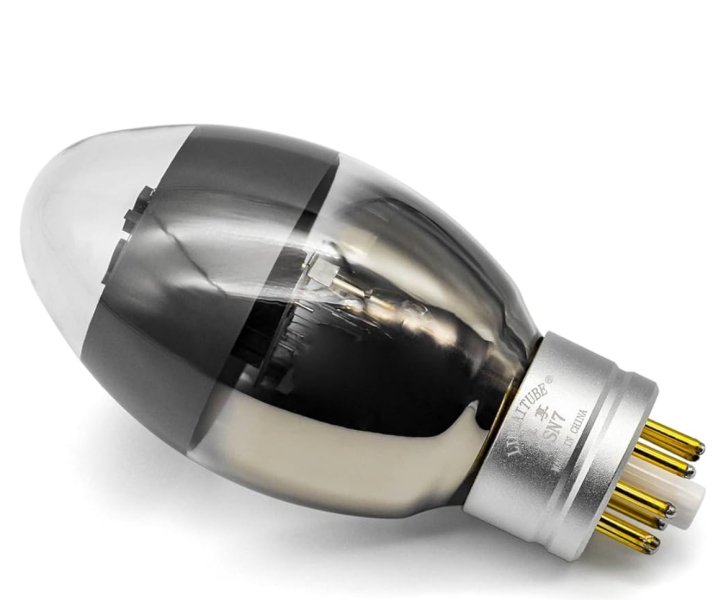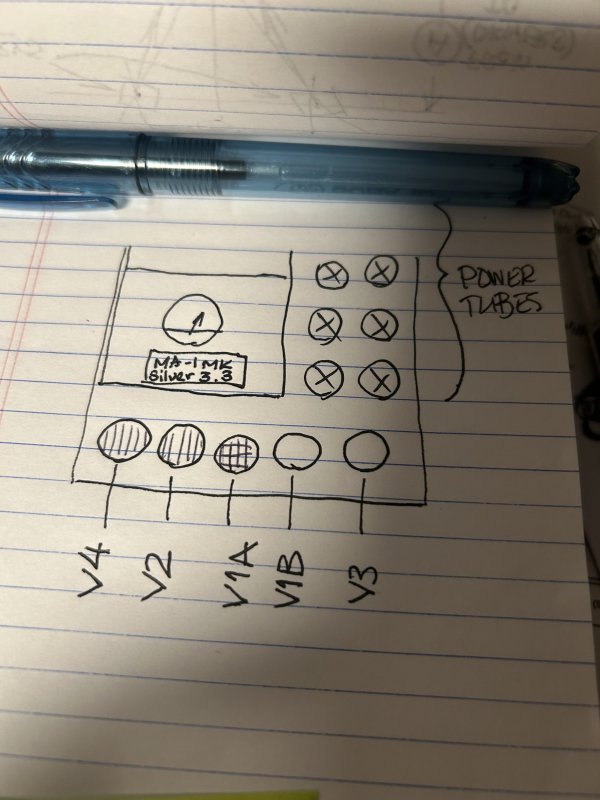Pardon the delay... finally, I can give an update on my 6SN7 trek.
Baseline refresher: for this post, I have replaced my NOS 1950's Tungsram 6SN7GT (cited above in entry # 272) with my recently acquired 1940's Sylvania VT-231 6SN7GT (image below) in the input section of my custom Blue Circle NSC preamp.

Sonic impressions: when I initially installed the Syl VT-231, it was very "crispy" in the highs; however, over the next 2-weeks it settled-in nicely (i.e., the crispy highs mellowed just a bit), leaving the following impressions: moving from the Tungsram, the Syl VT-231 reveals more high frequency information, enabling more musical details to come forth in the upper frequencies. But that's not all: I also detect that the body in the mids may be just a tad less "thick", meaning: I think the Syl VT-231 has also reduced some (previously undetected) "over exuberance" (noise?) in the mids, and my system now presents a slightly cleaner holographic scene in my musical landscape (soundscape). In hindsight, I like the overall small (nuanced) adjustment the VT-231 has introduced (brought forth). Thus, this tube is taking my system in a positive direction that suits my preferences towards my "ideal" sound. In contrast, I feel there is no sonic downside with this move (from what I like in my system, of course). Meaning, I am truly enjoying my music more! In conclusion, I like it very much!
Thus, here is the ranking of my very limited trial population (in order of preference), so far:
1. 1940's Slyvania VT-231 6SN7 GT
2. 1950's Tungsram 6SN7 GT
3. 1950's Sylvania "grey glass" 6SN7 GT
4. 2010's Electro-Harmonix 6SN7 GT (which came stock with the preamp)
The essential 6SN7 that still peaks my interest to try is the 1940's TungSol VT-231 6SN7 GT.
That's all for now.
Re-tread
Baseline refresher: for this post, I have replaced my NOS 1950's Tungsram 6SN7GT (cited above in entry # 272) with my recently acquired 1940's Sylvania VT-231 6SN7GT (image below) in the input section of my custom Blue Circle NSC preamp.

Sonic impressions: when I initially installed the Syl VT-231, it was very "crispy" in the highs; however, over the next 2-weeks it settled-in nicely (i.e., the crispy highs mellowed just a bit), leaving the following impressions: moving from the Tungsram, the Syl VT-231 reveals more high frequency information, enabling more musical details to come forth in the upper frequencies. But that's not all: I also detect that the body in the mids may be just a tad less "thick", meaning: I think the Syl VT-231 has also reduced some (previously undetected) "over exuberance" (noise?) in the mids, and my system now presents a slightly cleaner holographic scene in my musical landscape (soundscape). In hindsight, I like the overall small (nuanced) adjustment the VT-231 has introduced (brought forth). Thus, this tube is taking my system in a positive direction that suits my preferences towards my "ideal" sound. In contrast, I feel there is no sonic downside with this move (from what I like in my system, of course). Meaning, I am truly enjoying my music more! In conclusion, I like it very much!
Thus, here is the ranking of my very limited trial population (in order of preference), so far:
1. 1940's Slyvania VT-231 6SN7 GT
2. 1950's Tungsram 6SN7 GT
3. 1950's Sylvania "grey glass" 6SN7 GT
4. 2010's Electro-Harmonix 6SN7 GT (which came stock with the preamp)
The essential 6SN7 that still peaks my interest to try is the 1940's TungSol VT-231 6SN7 GT.
That's all for now.
Re-tread
Last edited:




